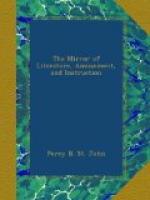sort will be found in the museum at Portici, both
in clay and bronze, but especially the latter; and
as the ornaments of the ancients have generally some
reference to some particular things, we often meet
with rather remarkable subjects.” A considerable
number of these articles will be found in the British
Museum, but they are chiefly of the commoner sort.
All the works, however, descriptive of Herculaneum
and Pompeii, present us with specimens of the richer
and more remarkable class, which attract admiration
both by the beauty of the workmanship, and the whimsical
variety of their designs. We may enumerate a few
which occur in a work now before us, “Antiquites
d’Herculanum,” in which we find a Silenus,
with the usual peculiarities of figure ascribed to
the jolly god rather exaggerated, and an owl sitting
upon his head between two huge horns, which support
stands for lamps. Another represents a flower-stalk,
growing out of a circular plinth, with snail-shells
hanging from it by small chains, which held the oil
and wick. The trunk of a tree, with lamps suspended
between the branches. Another, a naked boy, beautifully
wrought, with a lamp hanging from one hand, and an
instrument for trimming it from the other, the lamp
itself representing a theatrical mask. Beside
him is a twisted column, surmounted by the head of
a Faun, or Bacchanal, which has a lid in its crown,
and seems intended as a reservoir of oil. The
boy and pillar are both placed on a square plateau,
raised upon lions’ claws. But, beautiful
as those lamps are, the light which they gave must
have been weak and unsteady, and little superior to
that of common street-lamps, with which indeed they
are identical in principle. The wick was merely
a few twisted threads, drawn through a hole in the
upper surface of the oil-vessel; and there was no
glass to steady the light, and prevent its varying
with every breeze that blew.
Still, though the Romans had not advanced so far in
art as to apply glass-chimneys and hollow circular
wicks to their lamps, they had experienced the inconvenience
of going home at night through a city ill-paved, ill-watched,
and ill-lighted, and, accordingly, soon invented lanterns
to meet the want. These we learn from Martial,
who has several epigrams upon this subject, were made
of horn or bladder;—no mention, we believe,
occurs, of glass being thus employed. The rich
were preceded by a slave bearing their lantern.
This, Cicero mentions, as being the habit of Catiline
upon his midnight expeditions; and when M. Antony was
accused of a disgraceful intrigue, his lantern-bearer
was tortured, to extort a confession whither he had
conducted his master.[4] One of these machines, of
considerable ingenuity and beauty of workmanship, was
found in Herculaneum in 1760, and another, almost
exactly the same, at Pompeii, a few years after.




